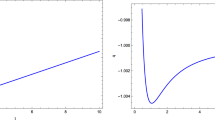Conclusions
As we have shown in the foregoing section, an asymmetric connection with nonvanishing torsion must be used to describe the gravitational interaction of a massive vector field. The following question arises: could one not eliminate the non-Reimannian part of the connection by modifying the Lagrangian? In my opinion, this cannot be done by a sufficiently natural modification of the orginal Lagrangian (5) and (9); for if one assumes, for example, that there exists a “direct” interaction of Vk with the gravitational field, i.e., the Lagrangian of the system of these fields has the form
where\(L_v = {\raise0.5ex\hbox{$\scriptstyle 1$}\kern-0.1em/\kern-0.15em\lower0.25ex\hbox{$\scriptstyle 2$}}\left( {fV^i V^l \eta _{ik} \wedge \Omega _l^k + gV_i V^i \eta _k^l \wedge \Omega _l^k } \right)\), the resulting equation for the connection will differ from (7a) by the presence on the left-hand side of an additive term of the form
It is readily seen that the presence of such a term cannot cancel the non-Riemannian part of the connection for any choice of f or g.
Finally, we mention that the equation for the field Vk obtained by varying the Lagrangian (9) with respect to Vk can be written with allowance for (13) in the form

where Ri is the term nonlinear in Vi and is a linear combination of terms of the type\(V^n \bar D^k V_i \bar D_k V_n \) and\(V^n V^k \bar D^n \bar D_k V_i \). We shall not give here the very cumbersome explicit expression for this term (which contains more than twenty terms).
Thus, the torsion of spacetime that results from the gravitational interaction of a massive vector field can be attributed to a nonlinear selfinteraction of the field Vk. The nonlinear term has a much more complicated structure that the corresponding nonlinear term for a spinor field [5, 6, 8].
Similar content being viewed by others
Literature Cited
A. Einstein, collected Works, Vol. 2 [Russian translation], Nauka (1966).
E. Cartan, Ann. Ec. Norm.,40, 325 (1923).
A. Trautman, Bull. Acad. Pol. Sci., serie sci. math. astr. et phys.,20, 185 (1972).
R.-L. Clerc, C. R. Acad. Sc.,272, A1145 and A1760 (1971); ibid. R.-L. Clerc, C. R. Acad. Sc.,274, A525 (1972).
F. W. Hehl and B. K. Datta, J. Math. Phys.,12, 1334 (1971).
B. K. Datta, Nuovo Cim.,6B, 1 (1971).
F. W. Hehl, Spin and Torsion in General Relativity, Preprint, Clausthal (1972) (to be published in Fortschr. Phys.).
V. I. Rodichev, Zh. Eksp. Teor. Fiz.,40, 1469 (1961).
B. A. Arbuzov and A. T. Filippov, Zh. Eksp. Teor. Fiz.,52, 1092 (1967).
B. A. Arbuzov, Zh. Eksp. Teor. Fiz.,56, 1946 (1969).
A. Lichnerowicz, Théorie Globale des Connexions at des Groupes d'Holonomie, Rome (1955).
Additional information
Institute of High Energy Physics, Serpukhov. Translated from Teoreticheskaya i Matematicheskaya Fizika, Vol. 18, No. 2, pp. 226–232, February, 1974.
Rights and permissions
About this article
Cite this article
Rochev, V.E. Massive vector field as a source of space-time torsion. Theor Math Phys 18, 160–164 (1974). https://doi.org/10.1007/BF01035915
Received:
Issue Date:
DOI: https://doi.org/10.1007/BF01035915



